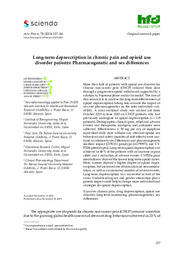Please use this identifier to cite or link to this item:
https://hdl.handle.net/11000/32350Full metadata record
| DC Field | Value | Language |
|---|---|---|
| dc.contributor.author | Muriel, Javier | - |
| dc.contributor.author | Escorial, Mónica | - |
| dc.contributor.author | Margarit, César | - |
| dc.contributor.author | Barrachina, Jordi | - |
| dc.contributor.author | Carvajal, Cristian | - |
| dc.contributor.author | Morales, Domingo | - |
| dc.contributor.author | Peiró, Ana | - |
| dc.contributor.other | Departamentos de la UMH::Farmacología, Pediatría y Química Orgánica | es_ES |
| dc.date.accessioned | 2024-06-27T10:34:53Z | - |
| dc.date.available | 2024-06-27T10:34:53Z | - |
| dc.date.created | 2022-11-18 | - |
| dc.identifier.citation | Acta pharmaceutica (Zagreb, Croatia) 73 (2023) 227–241 | es_ES |
| dc.identifier.issn | 1330-0075 | - |
| dc.identifier.issn | 1846-9558 | - |
| dc.identifier.uri | https://hdl.handle.net/11000/32350 | - |
| dc.description.abstract | More than half of patients with opioid use disorder for chronic non-cancer pain (CNCP) reduced their dose through a progressive opioid withdrawal supported by a rotation to buprenorphine and/or tramadol. The aim of this research is to analyse the long-term effectiveness of opioid deprescription taking into account the impact of sex and pharmacogenetics on the inter-individual variability. A cross-sectional study was carried out from October 2019 to June 2020 on CNCP patients who had previously undergone an opioid deprescription (n = 119 patients). Demographic, clinical (pain, relief and adverse events) and therapeutic (analgesic use) outcomes were collected. Effectiveness (< 50 mg per day of morphine equivalent daily dose without any aberrant opioid use behaviour) and safety (number of side-effects) were analysed in relation to sex differences and pharmacogenetic markers impact [OPRM1 genotype (rs1799971) a nd C YP2D6 phenotypes]. Long-term opioid deprescription was achieved in 49 % of the patients with an increase in pain relief and a reduction of adverse events. CYP2D6 poor metabolizers showed the lowest long-term opioid doses. Here, women showed a higher degree of opioid deprescription, but increased use of tramadol and neuromodulators, as well as an increased number of adverse events. Long-term deprescription was successful in half of the cases. Understanding sex and gender interaction plus a genetic impact could help to design more individualized strategies for opioid deprescription. | es_ES |
| dc.format | application/pdf | es_ES |
| dc.format.extent | 15 | es_ES |
| dc.language.iso | eng | es_ES |
| dc.publisher | Croatian Pharmaceutical Society | es_ES |
| dc.rights | info:eu-repo/semantics/openAccess | es_ES |
| dc.rights.uri | http://creativecommons.org/licenses/by-nc-nd/4.0/ | * |
| dc.subject | chronic pain | es_ES |
| dc.subject | drug deprescription | es_ES |
| dc.subject | opioid use disorder | es_ES |
| dc.subject | long-term monitoring | es_ES |
| dc.subject | pharmacogenetics | es_ES |
| dc.subject | sex differences | es_ES |
| dc.subject.other | CDU::6 - Ciencias aplicadas::61 - Medicina::615 - Farmacología. Terapéutica. Toxicología. Radiología | es_ES |
| dc.title | Long-term deprescription in chronic pain and opioid use disorder patients: Pharmacogenetic and sex differences | es_ES |
| dc.type | info:eu-repo/semantics/article | es_ES |
| dc.contributor.institute | Institutos de la UMH::Instituto de Bioingeniería | es_ES |
| dc.contributor.institute | Institutos de la UMH::Instituto Centro de Investigación Operativa | es_ES |
| dc.relation.publisherversion | https://doi.org/10.2478/acph-2023-0018 | es_ES |

View/Open:
Long-term deprescription in chronic pain and opioid use disorder patients. Pharmacogenetic and sex differences.pdf
760,35 kB
Adobe PDF
Share:
.png)
